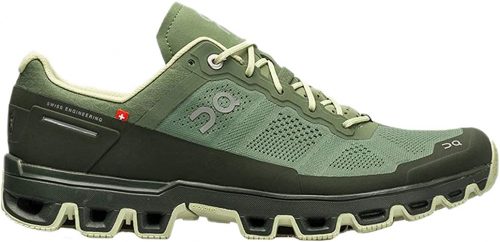Contents
Introduction
While gym-goers perform best around heavy equipment, some people would rather break a sweat in the great outdoors.
In another article, we have settled the score on whether or not it’s better to work out in the sun. From superb physical boosts to more challenging exercises, heading outdoors to train might just be the fitness upgrade that you need.
However, we’ve also warned that you could get exposed to a medley of injuries. The quickest fix? Investing in high-quality workout apparel.
We recommended you check out training gear that feels comfortable, but still powerful to protect you from all sorts of health complications brought by the weather and other natural elements. Finding the right workout companion can be a real struggle, but as always – Bodyweight Heaven is here to help.
For this blog, we dedicated about six months to comprehensively review of this new trending footwear – the On CloudVenture trail running shoes. We’ll break down On’s promised features and specifications, and see if it all checks out with our experience.
What makes Trail Running Shoes different?
If you’ve spent most of your training in a gym, it can take time before you can fully adjust to outdoor exercises. Apart from conditioning yourself physically and mentally, your wardrobe should start adapting too.
Unless you’re cool with extremely sore feet, think twice before using the same footwear you’d usually wear on a treadmill.
Want to venture out into rugged terrains like grassy fields or forests for your cardio? Then owning awesome trail running shoes is a must. This type of footwear is generally heavier – equipped with durable soles to shield your feet from ground obstacles you’ll encounter (e.g. sticks and rocks).
Read on to know how On made these possible with their CloudVenture model.
The CloudVenture Trail Running Shoes
Up for grabs for both men and women, CloudVenture is a lightweight trail running shoe powered by Swiss engineering.
This product is backed by the following proprietary technology developed by On:
- Missiongrip™ – developed to assist runners in conquering unlevel grounds. The shoes’ rubber materials provide traction as you climb summits and ample cushioning for when you head downhill.
- Speedboard™ – for protected yet comfortable runs, the shoes are designed with a narrower center capable of flexing your foot as you go over uneven terrains.
Taking comfort to the next level, CloudVenture’s upper boasts a technical engineered two-layer mesh – with a soft step-in and support for its inner layer, and a breathable, lightweight protective outer layer. With the shoes’ ventilation system, On promises a cooling comfort even during tough workouts.
On’s website also discussed the performance of CloudVenture with important buying considerations.
The shoes are best worn for training on mixed and trail surfaces, thanks to its moderate cushioning, neutral stability, and normal width. CloudVenture weighs 10.41 oz (295 grams) and has a heel-toe drop of 6mm.
Our Verdict
Having explored On’s brand promises, let’s see if reality met our expectations!
We’ll be reviewing CloudVenture’s performance based on three factors: tread, comfort, and protection. Each part will start with important considerations when buying trail running shoes, then we’ll proceed to discuss the things we loved and didn’t.
Tread
The tread’s design usually spells the difference between trail-running and ordinary road-running shoes.
Deeper (5mm to 7mm), wider-spaced lugs will give you better traction in the mud. However, they’d be a real hassle to wear when running on pavements and firm grounds. If you plan to train on trails with hard-packed soil, it would be best to buy shoes with shorter (2mm to 4mm), closely spaced lugs.
You also have to consider how rocky the trail you’ll run on would be. To avoid that stabbing sensation with every step on gravel, check if the shoes’ outsole is equipped with a protective plate against rock bruising. This can come in the form of a rock plate or a nylon shank attached to the footwear’s midsole. As a downside, this added layer tends to make shoes feel heavier.
What CloudVenture got right
The CloudVenture’s trail running shoes featured deep, airy-spaced lugs which we liked. True to On’s promise, they provided awesome downhill grip action with its rubber’s Missiongrip™ technology. Its Speedboard™ tech also gave a cloud-like feeling even when running on uneven trails.
With its lugs’ height, CloudVenture offered a great protective lift from all sorts of ground debris.
What we wish CloudVenture would improve on
Although it did provide ample lift, its outsole’s design tends to pick up small rocks in the heel and midportion.
It was quite frustrating that I’ve had some rocks stabs while running. Every time I was about to pass through rocky trails, I had to brace myself for that uncomfortable and sometimes painful sensation at the forefront of my feet.
CloudVenture seems to focus on comfort and being lightweight, thus foregoing protective features against rock bruising. A rock plate could’ve made running on gravel feel a lot less of a torture.
Cushioning and Comfort
Footwear brands seem to have different takes on cushioning for running shoes. Many have opted to develop minimalist products with less cushioning to give runners that “one-with-the-ground” feel. Meanwhile, others preferred to release models with more cushion layers than ever.
Wondering which variant is best for you? It all depends on the kind of trail you’ll train on and the distance you wish to conquer.
We recommend less cushioned running shoes for those who will work with soft, smooth grounds in shorter trails. Conversely, heavy cushioning is fit for those who will cover long distances on hard-packed trails.
In case you want added protection from knee and joint pain, you can greatly reduce ground impact by going for footwears with more cushion layers.
What CloudVenture got right
For footwear with such a stiff last, CloudVenture’s comfort level is incredible! Expect a lightweight, ultra-cozy feeling the moment you first put them on. The shoe insert worked really well and provided another layer of cushioning. Generally, its thick insole complemented my runs.
I also found On’s promise of an optimum ventilation system to be true. CloudVenture and it’s upper’s mesh materials provided great breathability and comfort for my feet.
What we wish CloudVenture would improve on
I personally love stiff shoes, but this attribute could also have its drawbacks.
The multi-layered mesh design of CloudVenture’s upper can be quite restrictive. I did not encounter this problem, but we’re afraid this product will not be suitable for all foot shapes.
If you have a wider than average forefoot, you’d probably find it uncomfortably tight.
Stability and Protection
Your trail running shoes are meant to be your protective companion against nature’s challenges, so be sure to check if its materials and design can withstand all sorts of obstacles. Moreover, you shouldn’t be fumbling with your laces every now and then.
Consider as well how high the shoes’ heel-to-toe drop is. Basically, this specification will tell you the difference between the cushioning in the heel and the toe area.
Here’s what those extra millimeters mean. Shoes with a lower heel-to-toe drop tend to cause a midfoot strike, while higher ones will cause you to land on your heels as you run.
Those with less than 4mm drop measurements will require longer adjustment periods and added effort from your Achilles tendon. This type of trail running shoes would also make uphill runs more difficult.
What CloudVenture got right
Setting the issue on rock bruising aside, CloudVenture’s thick and stiff outsole rubber offers superb toe and heel protection. Its strong torsion control brought by the Speedboard™ tech also made me feel safer from running injuries.
These protective features are complemented by CloudVenture’s durable materials and great lacing system. I can even imagine it lasting years-worth of use.
Moreover, I also liked how the overlay along the base of the shoe offers extra protection against external elements snow, water, and mud.
What we wish CloudVenture would improve on
Although I’ve mentioned that CloudVenture has a good lacing system, I was bothered that they tend to loosen up after about six miles of running. It’s probably caused by how thin the laces are, which can also be challenging to work with if you’re wearing gloves.
If you want a quick fix for this issue with the laces, I’ve made a video demonstrating a loop technique that could help. Be sure to check it out on YouTube!
Overall Rating: 7 out of 10
All factors considered Bodyweight Heaven would give On’s CloudVenture shoes a 7 out of 10. It’s not our favorite among all the trail running gears we’ve tried, but we still found it worthy to be recommended.
Priced at $150 each pair, some of you might find CloudVenture really expensive. But with the Swiss engineering and durable materials that power these shoes, you will definitely get your money’s worth.
These shoes are great for running on dry dirt trails, but consider yourself warned if you’re planning to train on gravel or rocky grounds.


